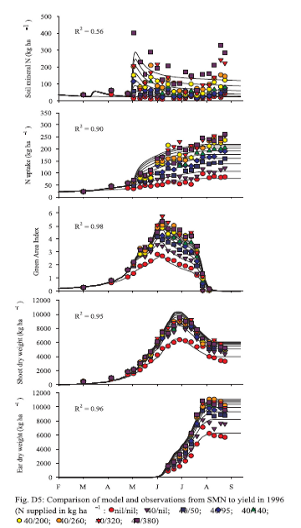Wheat growth modelling (and other cereals) by inverse thoughts of parsimonious model concepts
The GNR model concept for wheat growth modelling (applicable
for all cereals)
Central idea: nitrogen uptake and biomass growth, i.e. (yield) is driven by canopy
expansion and canopy prolongation. The canopy is measured as Green
Area Index (GAI), taking into account total green biomass instead of
the common LAI. Both, canopy expansion and longevity are functions
of temperature and precipitation. Additional stresses affect (shortens)
canopy longevity and result in yield losses.
 |
|
Further explainations:
|
|
Switch function concepts Within the model partiones the season of greenish tissue into three phases: I. canopy expansion, II. canopy duration & III. rapid senescence until canopy death. Biomass growth finally stops with canopy death |
The model concept offers suitable links for modelling major multiple stresses and more interesting the discrimination of each stress.
Conclusion: The model concept takes into account a complete different perspective on cereals physiology and yield determination. The way of simplification of complex, time varying, physiological processes is certainly arguable. But it includes a certain fascination by being a complex, but simulatanous regression problem over five compartments and by agreeing with the observations on different scales, seasons and locations with a an accuracy above 95%. In its concept it is contrary to the thinking of all major cereal models, which nowadays are used for yield prediction influenced climate


